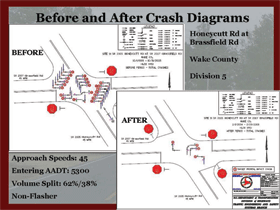U.S. Department of Transportation
Federal Highway Administration
1200 New Jersey Avenue, SE
Washington, DC 20590
202-366-4000
| HSIP Project Evaluation | Table of Contents | University Conducting HSIP Project Evaluations Using Empirical Bayes – Wisconsin >> |
Best for printing: [PDF] (2.3 MB)
To view PDF files, you can use the Acrobat® Reader®.
In 1999, the North Carolina Department of Transportation (NCDOT) created a permanent group of employees to focus on safety project evaluation. The purpose for the group was to establish a formal project evaluation process to verify the success of the state’s efforts in safety.
In the first four years following its formation, the group established a process for conducting project evaluation and identified what results would be most useful to the field engineers. The group’s initial efforts were more research and technically oriented but, to better serve the needs of the field engineers, the results of the evaluation studies were simplified (the field engineers were most interested in the before and after crash diagrams and changes in crash patterns). Originally, the group conducted about 50 project evaluations a year with one supervisor and six engineers, but now the group completes approximately 200 evaluations a year with reduced staff (one supervisor, four engineers, and one technician).
The safety evaluation group conducts simple before-after studies on all spot safety projects once a minimum of three years of before and after data are available (the same time periods are used for both the before and after periods). For each project, the group prepares an evaluation report including before and after crash type and severity data, collision diagrams, photos, and discussion of the study results. After an evaluation report is completed, it is submitted to the field engineer who originally developed the project to provide feedback on whether the project successfully mitigated the previously identified safety issue. For projects unsuccessfully mitigating the safety issue or resulting in a different crash pattern, the evaluation report provides the field engineer with an opportunity to reassess the conditions and identify a different countermeasure. NCDOT is currently working on developing a process to track projects not successfully mitigating the safety issue they were intended to address.
The evaluation group compiles a spreadsheet of all the completed project evaluation studies. The spreadsheet provides the category of improvement, before and after traffic volumes, location, traffic control, geometry, etc., and provides a link to the detailed evaluation report. The spreadsheet is updated regularly and posted on the NCDOT web site (http://www.ncdot.org/doh/preconstruct/traffic/safety/Reports/completed.html). It can be used by engineers to determine which treatments have worked in the past.
The group also develops crash modification factors (CMF) using the Empirical Bayes (EB) method when enough sample sites and data are available. North Carolina specifically focuses on developing CMFs for countermeasures not already extensively researched.

In efforts to promote a particular countermeasure to the field engineers, NCDOT’s evaluation group has also conducted studies on well documented countermeasures to provide evidence of crash reduction effectiveness. One example is the use of four-way stop control. Although several studies document the effectiveness of this countermeasure, many field engineers in North Carolina did not consider it a viable countermeasure. The group evaluated over 50 intersections throughout the State and demonstrated four-way stop controls were effective. Study results were presented to field engineers in an effort to change their perspective. While field engineers were very receptive to the study results, it is too early to determine if it has increased the use of four-way stop control in the State.
Since the establishment of the safety evaluation group, North Carolina has evaluated and documented the results of more than 600 projects. The evaluation reports provide field engineers with valuable feedback on the effectiveness of their safety projects, as well as various countermeasures, and promote the use of effective countermeasures.
Shawn Troy
North Carolina Department of Transportation
919-773-2897
stroy@ncdot.gov
| HSIP Project Evaluation | Table of Contents | University Conducting HSIP Project Evaluations Using Empirical Bayes – Wisconsin >> |
